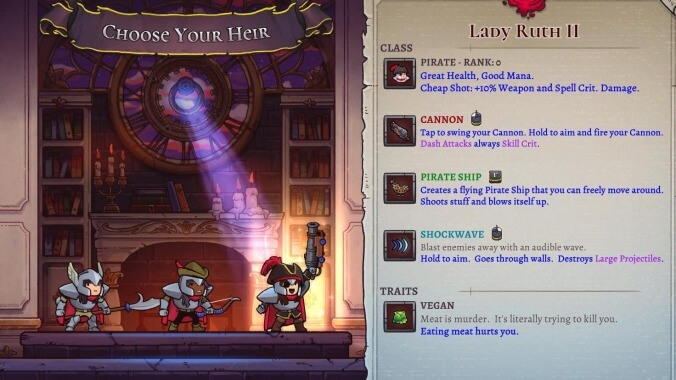Rogue Legacy 2 is an across-the-board improvement of a gaming classic
Cellar Door's sequel goes light on reinvention, heavy on refinement (and "Super IBS")

Every Friday, A.V. Club staffers kick off our weekly open thread for the discussion of gaming plans and recent gaming glories, but of course, the real action is down in the comments, where we invite you to answer our eternal question: What Are You Playing This Weekend?
How do you make a sequel to a game that’s supposed to go on forever?
It’s a question that’s gotten quite a bit more relevant over the last 10 years of gaming, as a number of trends—the rise of the procedurally generated rogue-like genre, the advent of microtransaction-powered “Games As Service” design, and a general focus on updating existing games long after their initial release dates have come and gone—have collided to create the perpetually sought after Forever Game. (That is, a game that can be picked up and played forever; in hindsight, we probably didn’t need this parenthetical to spell that concept out, huh?) And the Forever Game has no need for sequels; it is, in fact, a refutation of the whole concept that further game could ever be needed, or desired.
Rogue Legacy, released by Cellar Door Games back in 2013, wasn’t quite a Forever Game as they exist today. Despite a procedurally generated castle, and a variety of patched-in features designed to get players to revisit it, the game itself had a finite goal and a clear ending: Kill the four bosses lurking deep in the haunted castle, beat the boss, save your family from an endless curse (and their wide variety of run-defining mutations and quirks). Even so, its sequel, which exited Early Access back in late April, is a fascinating look at how you can take a game that’s functionally already “more of the same, forever” and render it somehow fresh.
On a zoomed-in level, and just generally at first glance, Rogue Legacy 2 plays almost identically to its predecessor, albeit with a snazzy, cel-shaded new coat of paint. Players still guide members of a family with a lot of genetic drift through the halls of a randomly generated castle, with death (and fortune) the inevitable outcome. The money from each run is then pumped back into the family estate, allowing each generation of explorers to be a little stronger than the one that just bit it. Choosing your new character means selecting an heir, weighing their class, choice of magical spell, and a whole bunch of those aforementioned quirks—most of which change how the game plays in meaningful, sometimes hilarious ways—against each other to try to set yourself up for success (or an interesting, “Super IBS”-afflicted failure).
On first blush, Rogue Legacy 2's approach to these systems appears depressingly copy-and-paste. Not least of which because Rogue Legacy’s power loop—genuinely fresh nine years ago—has since been copied extensively, to the point that it’s now a cornerstone of the “Do a run, get stronger, do a slightly better run, etc.” genre sometimes known as “roguelites.” Seeing Rogue Legacy 2 trod that exact same territory when you first boot it up is a serious bummer (especially when we first checked it out in early access, before most of the game’s more interesting twists had been implemented). Once you push past those opening impressions, though, you begin to see how Cellar Door has expanded that basic premise—and pushed itself, design-wise—to make something meaningfully different from the game’s predecessor.
The first major change to reveal itself is the game’s level design; although RL2's initial castle levels could have been CTRL-V’d from the original game, every subsequent area feels radically different, from a horizontal bridge built around long-distance jumping puzzles, to a snowy mountain that ramps up the danger of environmental traps. Each room also feels far more meticulously designed, built to take advantage of the game’s quick-flowing movement and test your abilities. “Thoughtful,” in fact, is a word that keeps popping up in our analysis of RL2, as we also started to unlock classes which fundamentally change how each run plays out—and which reveal that Cellar Door has clearly been thinking about their combat systems behind the simplistic hack-and-slash of the original. Even the manor-building mechanic—still a simple skill tree—has become more planning-focused and mechanically robust, forcing you to genuinely think about which investments will keep your horde of heroes alive long enough to grab a precious extra sack or two of gold.
Rogue Legacy 2 isn’t a seismic shift of a sequel like, say, Risk Of Rain 2, which essentially adapted its side-scrolling parent title into the framework of a 3D exploration shooter, maintaining shared items and language while radically altering the core gameplay. But it justifies its existence by being, on almost every metric, a better version of the systems created for Rogue Legacy 1, and also just a better game in general. It’s a fascinating example of what nearly a decade of improvement can look like: Refinement, rather than revolution. We might not be playing it forever, but it’s a pleasant addition to the canon today.